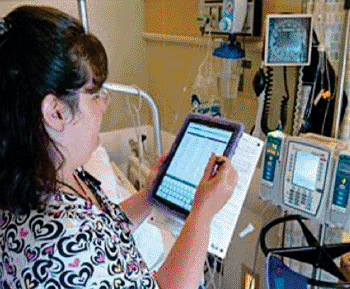iPad app Helps Physician Capture Trauma Patient Data
By HospiMedica International staff writers
Posted on 22 Jan 2014
A novel iPad app assists trauma center doctors accurately collect and analyze trauma care and outcomes data, replacing paper-based data.Posted on 22 Jan 2014
Researchers at the University of British Columbia (UBC; Vancouver, Canada), and Vancouver General Hospital (VGH; Vancouver, Canada) redesigned the Groote Schuur Hospital (Cape Town, South Africa) one-page paper electronic Trauma Health Record (eTHR) patient admission form into an iPhone app. To do so, they worked with an advisory group of trauma clinicians, data ethnographers, and medical software designers. The Groote Schuur surgeons opted for the iPad mini over the full-sized iPad, which could fit in their lab coat pockets and reduce the risk of theft.

Image: Staff member filling in the iPad mini record (Photo courtesy of Groote Schuur Hospital).
The goal was to ensure that completing the iPad record did not impede clinical workflow and integrated other helpful elements such as safety checklists, evidence-based guidelines, and the ability to easily print, download, and upload the record to a clinical database. The iPad mini record also captured important information that could be used for later analysis, such as past medical history, residence, demographics, the cause of the injury, the injury severity score, and the patients' drug and alcohol use.
After usability testing, the Groote Schuur Hospital surgeons used the iPad app to capture admissions data for 50 patients who came to the hospital during June 2013 for trauma care for conditions that included limbs that required amputations; gunshot wounds to the head, neck, chest, or abdomen; facial burns, and traumatic cardiac arrest. It took surgeons about 10-12 minutes to complete the iPad record, versus 10 minutes or less on paper, but the surgeons were thus able to upload the data directly to a server that created a trauma patient registry.
When analyzing the data to look for patterns, they found injuries were concentrated in lower income areas and most of the causes of injury were intentional, with the predominant injury population being young males. By quantifying such data, policy interventions, such as determining which highway intersections need traffic lights and which populations should be the target audience for injury prevention programs can be implemented. The study describing the development process was published in the January 2014 issue of the Journal of the American College of Surgeons.
“People think injuries are accidents, and nothing can be done, but most injuries are preventable. With the right data and the right health care standards you can make a favorable impact,” said lead author associate professor of surgery and critical care medicine Morad Hameed, MD. “Even though it takes as long or slightly longer on an iPad, the database is very clean and doesn't require a lot of data cleanup.”
The eTHR study won the first-place award for clinical research at the American College of Surgeons (ACS) Committee on Trauma meeting, held during November 2013 in Phoenix (AZ, USA).
Related Links:
University of British Columbia
Vancouver General Hospital
Groote Schuur Hospital














